Whether you're building your personal brand or running social media marketing for a business, choosing the right social media platforms matters. It’s not just about being where everyone is — it’s about being where your audience already shows up.
That’s why we put together this guide: a look at the top social media platforms in 2025, ranked by monthly active users and updated with insights on what each platform is best for.
From familiar giants like Facebook and Instagram to rising players like Threads and Bluesky, this list will help you make smarter decisions about where to show up and what kind of content to create.
And remember: you don’t need to be on every social media site to grow a strong social media presence. A focused strategy that aligns with your target audience, content strengths, and available time will always beat being spread too thin.
But first, an overview of the most popular social media platforms
Jump to a section:
The top 24 social media apps and platforms for 2025
This list is ranked by the latest data on monthly active users (MAUs)*.
While it's useful to see the sheer volume of users each site has, it doesn't necessarily mean the one with the biggest user base is the best for your brand. If your target audience is not active there, the platform isn't worth the time and effort it will take to manage it.
Start your social media marketing strategy by pinpointing where your ideal customers are active to get the best return on investment (ROI) for your business.
1. Facebook
3.065 billion MAU

Facebook remains the largest social media platform in the world, with more than 3 billion monthly active users — that’s over one-third of the global population. It continues to be a core part of most social media marketing strategies, thanks to its broad audience reach and support for nearly every type of content format.
More than 200 million businesses use Facebook’s tools, and over seven million brands advertise on the platform — making it one of the most popular social media sites for business.
Why Facebook still matters:
- Works well for text, images, video content, stories, and live streams
- Features like Facebook Groups and Facebook Messenger allow deeper community building and customer engagement
- Facebook Ads Manager gives precise targeting for paid social media campaigns
Pro tip: Here’s how to grow your Facebook following and make the most of the algorithm — it rewards content that sparks conversations between friends, families, and communities.
2. WhatsApp
2.95 billion MAU

WhatsApp is the world’s most popular messaging app, used in over 180 countries and by nearly 3 billion people every month.
Originally built for personal messaging, it has since evolved into a valuable social media platform for customer service, community updates, and business marketing.
Why use WhatsApp:
- WhatsApp is designed for small businesses to share updates, showcase products, and answer questions directly
- Larger teams can use the WhatsApp Business app to automate responses and integrate customer communication at scale
Whether you're updating customers on orders, offering real-time support, or broadcasting limited-time deals, WhatsApp is a great platform to reach users where they're most engaged, especially in regions where text messaging is the primary form of communication.
WhatsApp’s end-to-end encryption and no-algorithm feed make it ideal for direct communication, not discovery. But when used well, it builds trust and loyalty with your target audience.
3. YouTube
2.5 billion MAU

YouTube is more than a video sharing platform — it’s the second-largest search engine in the world (after Google, its parent company). With users watching over a billion hours of video daily, it’s a must-have platform for any brand investing in video content.
Why YouTube matters for your marketing strategy:
- Supports both long-form and short-form videos (including YouTube Shorts)
- Great for evergreen content, tutorials, behind-the-scenes, and storytelling
- Works well for search-driven discovery and subscriber growth
SEO plays a huge role in visibility here. Optimizing your videos with the right keywords, thumbnails, and engagement strategies can help your content reach the right viewers over time.
Whether you’re new to YouTube or refining your current presence, here’s how to grow on YouTube and start building a community through content.
Learn more about YouTube SEO, the YouTube algorithm, and how to grow your audience.
4. Instagram
2.04 billion MAU

Instagram is one of the most visual social media platforms, built for sharing photos, videos, Stories, and short-form video content like Reels.
With over 2 billion monthly active users, it’s especially popular with millennials and Gen Z — making it a top choice for brands looking to connect through visual storytelling.
Why brands love Instagram:
- A wide range of formats — including Reels, Stories, and Live video — keeps content fresh
- Strong discovery tools like the Explore tab and hashtags help grow reach
- Encourages user-generated content through mentions, tags, and branded campaigns
You can switch to an Instagram business profile to unlock in-depth analytics and scheduling tools. It’s also easy to cross-post to Facebook, Threads, and Messenger since they’re all part of the Meta family of platforms.
Want to grow? The Instagram algorithm favors content that gets quick engagement — likes, saves, shares, and comments. Here’s a complete guide to Instagram growth in 2025.
5. TikTok
1.5 billion MAU

TikTok has quickly become the go-to short-form video content platform, especially among younger audiences.
With 1.5 billion monthly active users and a global reach, it’s one of the most engaging social media platforms out there — and a top choice for creators, small businesses, and brands looking to show up in a more personal, creative way.
What makes TikTok unique:
- Users can create videos up to 10 minutes long (which we’ve found get more views) with built-in music, voice effects, and editing tools
- The algorithm is laser-focused on user behavior — meaning anyone can go viral
- Challenges, duets, and trends help brands participate in culture, not just broadcast messages
If your target demographic includes Gen Z or younger millennials, TikTok can be a powerful place to connect through authentic, fast-moving content.
Concerned about the TikTok ban? We’ve got you covered — here’s everything we know about the potential TikTok ban in the U.S., and how to prepare just in case.
Want to grow? Learn how the TikTok algorithm works and how to get more followers — from content hooks to posting strategy.
6. WeChat
1.34 billion MAU

Interested in expanding your social media presence internationally? WeChat could be your gateway to one of the largest online markets in the world.
WeChat, developed by Chinese tech giant Tencent, is one of the most versatile social media platforms in the world — especially across China and parts of Asia.
Originally a messaging app, WeChat has grown into an all-in-one platform where users can send messages, make payments, shop online, book rides, and more.
Why WeChat stands out:
- One of the only major social networking sites not blocked in China
- Offers branded WeChat Official Accounts for businesses, which act like mini-websites
- Enables businesses to run ads, build mini-programs (apps within WeChat), and reach audiences directly through WeChat Moments
If you’re trying to reach users in China — where platforms like Facebook, X (formerly Twitter), and Instagram are restricted — WeChat is the dominant option for both personal and business communication.
You can also partner with Chinese influencers to promote your brand through stories and content within the WeChat ecosystem.
7. Telegram
900 million MAU

Telegram is a fast-growing messaging app known for its privacy-first approach and flexibility.
While it started as a simple chat tool, it’s evolved into a full-fledged social media platform with channels, communities, bots, and broadcast tools — all of which make it a powerful option for creators and brands.
What sets Telegram apart:
- End-to-end encryption for messages and files
- Massive group and channel support — with channels accommodating up to 200,000 subscribers
- Bots and automation for delivering content, collecting feedback, or even processing purchases
Because of its minimal algorithmic interference, Telegram is ideal for direct audience communication — perfect for newsletters, product updates, and community building without the noise.
While not designed for discovery like TikTok or Instagram, Telegram excels at deepening engagement with an already interested target audience.
You can even build mini ecosystems on Telegram using its bots and API integrations — useful for tech-savvy brands and creators.
8. Snapchat
800 million MAU

Snapchat pioneered the idea of disappearing content and vertical video — both of which have become staples across other social media platforms like Instagram and TikTok. With 800 million monthly active users globally, Snapchat remains a powerful messaging app and visual content platform, especially among younger audiences.
Why Snapchat should have a place in your strategy:
- Strong engagement with Gen Z and U.S. teens (nearly 70% use the app)
- Features like Lenses, Bitmoji, and private Stories make it highly interactive
- Newer tools like My AI and Spotlight aim to keep users engaged and creators supported
While Snapchat may not be as central to social media marketing strategy as Instagram or TikTok, it still plays a key role in reaching specific target demographics — especially if your brand skews younger or lifestyle-driven.
9. Douyin (TikTok China)
766.5 million monthly active users

Douyin is the Chinese version of TikTok — developed by ByteDance and launched before its global counterpart. While they share the same interface and video-first format, Douyin operates separately from TikTok and has its own ecosystem, rules, and user behavior.
With around 766 million monthly active users, Douyin is a leading social media platform in China and a powerhouse in short-form video content and social commerce.
Why Douyin stands out:
- Advanced in-video e-commerce integrations — users can buy directly from videos and livestreams
- Rich data and AI-driven recommendations for hyper-personalized feeds
- Popular for tutorials, product reviews, behind-the-scenes content, and shopping hauls
For brands and creators targeting the Chinese market, Douyin offers a highly engaged, transaction-friendly audience — and a glimpse into the future of video-led commerce.
10. Kuaishou
735.6 million MAU

Kuaishou is one of China’s largest video-focused social media platforms, and a key competitor to TikTok (known as Douyin in China).
With around 735 million monthly active users, it’s especially popular in lower-tier cities and rural regions of China — offering a unique space for creators and brands to reach underserved audiences.
What makes Kuaishou different:
- Strong emphasis on authentic, everyday storytelling over high-gloss trends
- Supports long-form video, short-form content, and live streaming
- Leans heavily on e-commerce revenue, with built-in tools for product discovery and purchasing
Kuaishou has a reputation for being more community-driven and less algorithmically intense than TikTok or Douyin, the Chinese version of TikTok. This gives smaller creators more room to grow and makes the platform an interesting option for social commerce.
If you’re targeting the Chinese market or exploring cross-border e-commerce, Kuaishou is worth exploring as part of a broader social media marketing strategy.
11. Reddit
632 million MAU
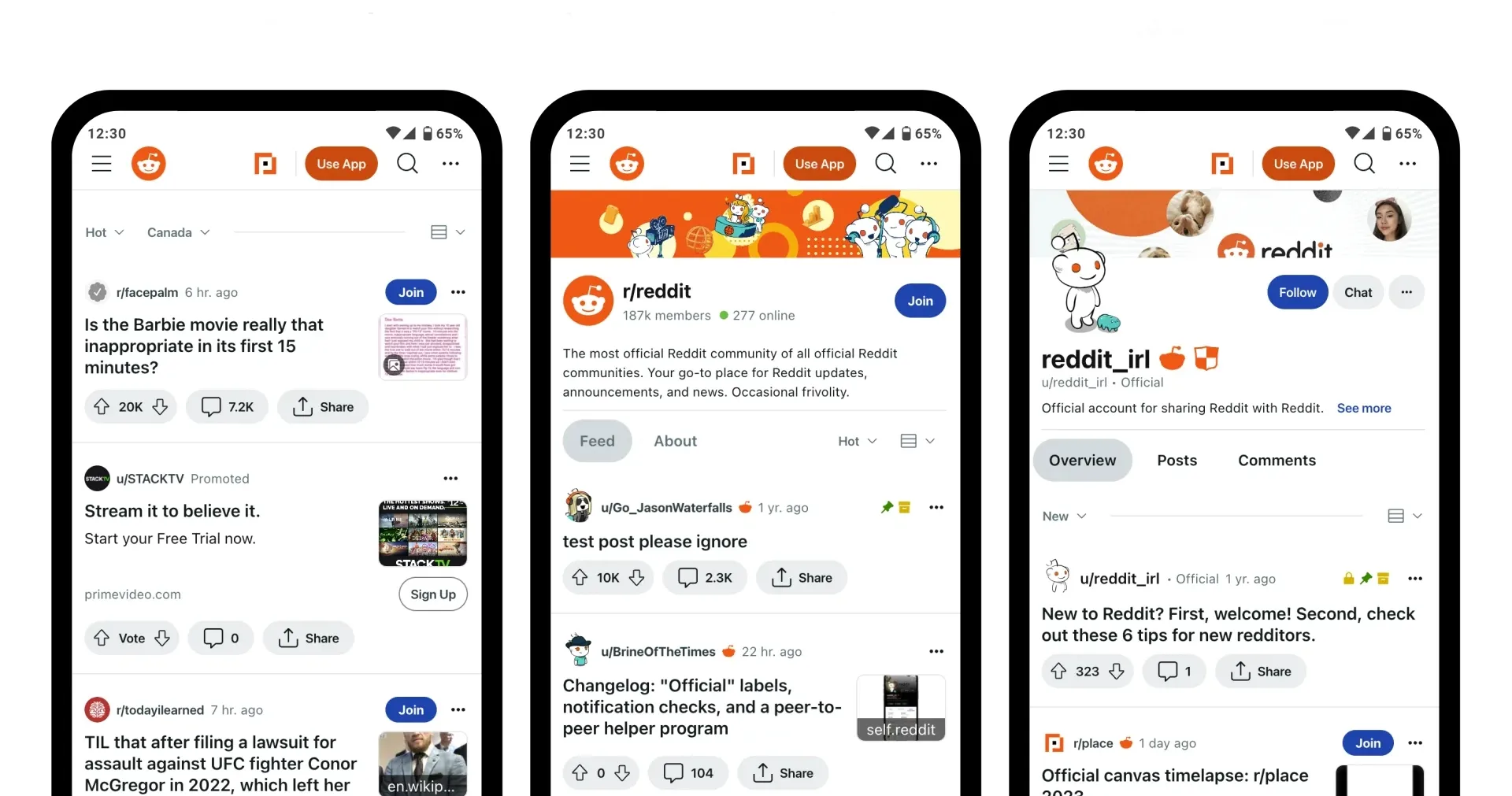
Reddit is a hybrid discussion platform and social network made up of thousands of niche communities called subreddits.
With 632 million monthly active users, it’s a go-to platform for in-depth conversations, advice, crowd-sourced knowledge, and cultural commentary.
Why Reddit is different:
- Forums exist for virtually every topic — from skincare to startups to AI
- Social media users engage anonymously, which encourages honest discussion
- Subreddits like r/beauty or r/entrepreneur are hubs of trusted peer insight
Reddit isn’t about polished content — it’s about showing up with value. That makes it ideal for brands and creators who want to listen before posting and engage with communities thoughtfully.
Keep in mind that most subreddits don’t allow blatant self-promotion. Your best bet for success on the platform is to offer insights, ask smart questions, and share content that’s genuinely useful to your target audience.
12. Sina Weibo
590 million MAU

Sina Weibo is a Chinese microblogging platform that combines features of Twitter and Instagram.
With about 590 million monthly active users, Weibo remains one of the largest social networking sites in China and a powerful channel for trend discovery, influencer marketing, and brand visibility.
Why Weibo is a top choice:
- Content includes images, videos, Stories, live streams, and hashtags
- Highly active around entertainment, news, beauty, fashion, and tech
- Offers official and verified business accounts, plus ad placements
Compared to WeChat, Weibo’s audience is younger and more trend-focused. It’s the platform where many viral movements and conversations start — and where brands can join cultural conversations in real time.
Interested in going viral in China? The New York Times once called Weibo “the place to be” — and for good reason.
13. Pinterest
570 million MAU

Pinterest is where inspiration meets action. With 570 million monthly active users, it’s a visual social media platform that functions more like a discovery engine than a traditional feed.
Users “pin” images and videos linked to blogs, products, and landing pages — making it a strong driver of traffic and purchases.
Why Pinterest works for brands:
- Pinterest users are 7x more likely to purchase products they’ve saved
- Especially popular for niches like fashion, home decor, wellness, DIY, and food
- Ideal for user-generated content and evergreen posts with long shelf lives
Whether you’re promoting blog content, e-commerce listings, or tutorials, Pinterest helps you show up when people are actively searching for ideas — making it a valuable addition to your social media marketing strategy.
14. QQ
554 million MAU

QQ, also developed by Tencent, was once China’s top instant messaging app before WeChat took the lead.
Today, with over 550 million monthly active users, QQ still holds strong — especially among younger users, gamers, and professionals looking for lightweight communication and file sharing.
Why QQ has a loyal user base:
- Popular for its desktop-friendly interface and ability to transfer large files (over 25 MB)
- Offers a social feed, avatar customization, and built-in online games
- Doesn’t require a phone number to sign up — appealing to students and users without smartphones
QQ is more than a messaging tool — it’s a full social experience, especially in China’s youth culture. For brands targeting the Chinese workforce or teen audience, QQ can be a lower-pressure alternative to flashier social media platforms like WeChat or Douyin.
While it’s not a major channel for global marketing, QQ is still a key part of China's broader social media landscape — and a reminder that different markets often respond to very different tools.
15. LinkedIn
~350-400 million MAU

LinkedIn is the leading professional networking platform, originally built for job seekers and recruiters — but now just as valuable for creators, small business owners, and brands.
With between 350-400 million monthly active users, LinkedIn has become a hub for sharing ideas, building authority, and nurturing your personal brand.
Why LinkedIn is a must for professionals and brands:
- Ideal for B2B marketing, industry insights, and employer branding
- A powerful space to establish thought leadership through articles, carousels, and video content
- The algorithm rewards consistency and meaningful engagement (especially comments)
Whether you're building a business presence or growing as a solo creator, LinkedIn offers one of the highest ROIs for content visibility — especially if your target audience includes decision-makers or professionals.
Learn how the LinkedIn algorithm works, how to grow your followers, and how to build a standout personal brand.
16. Threads
350 million MAU

Threads, developed by Meta as a companion to Instagram, launched in mid-2023 and quickly became one of the fastest-growing social media apps in history — reaching 100 million sign-ups in just a few days.
As of early 2025, it now has over 350 million monthly active users.
What makes Threads different:
- A text-first platform for short-form updates, commentary, and casual conversation
- Integrated with Instagram — your username, following, and cross-posting carry over
- An alternative to its counterpart X, with regular feature rollouts
Threads is still evolving, but it’s quickly become a space for creators, founders, and brands to build connections through short-form content without pressure. Many use it for behind-the-scenes updates, audience questions, and less polished thoughts.
Want to grow on Threads? We broke down the platform’s best features and how to use them to build community and brand visibility.
17. X (formerly Twitter)
335.7 million MAU

X, formerly known as Twitter, continues to be a major player in social media, with over 335 million monthly active users.
While the platform has undergone significant changes since its rebrand in 2023, it still thrives on real-time audience interaction, trending topics, and short-form updates.
What makes X unique:
- Emphasis on timely content — from breaking news to live commentary
- A home for text-first content, making it ideal for thought leadership, humor, and hot takes
- Still a powerful customer service channel, used by brands for fast, public support
Despite fluctuating user trust and platform changes, X remains useful for brands with a fast-moving content strategy or a desire to connect directly with niche communities.
Learn how the X algorithm works and how to grow your following on X, whether you’re building a personal brand or managing a business account.
18. Quora
400 million MAU

Quora is a discussion platform built around questions and answers — where users share knowledge, give advice, and rank responses through upvotes and views.
With 400 million monthly active users, Quora continues to be a valuable space for brands and creators to build trust and reach users during the research phase of decision-making.
Why Quora works:
- High intent audience — many users are actively researching purchases or trying to solve a problem
- Evergreen visibility — a great answer can rank in Google search and stay visible for years
- A space to showcase subject-matter expertise and link back to your site, product, or content
As part of your social media marketing strategy, Quora can help you reach your target audience with content that feels helpful, not promotional. You can answer industry-relevant questions, create a Quora page for your business, or even run ads through Quora’s ad platform.
19. RedNote (Xiaohongshu/Little Red Book)
300+ million MAU

Xiaohongshu, also known as RedNote or Little Red Book, is a fast-growing social media platform based in China that blends lifestyle content, product discovery, and e-commerce.
With over 300 million monthly active users, it’s often described as a hybrid of Instagram, Pinterest, and Amazon reviews — especially popular among Gen Z and Millennial women.
Why RedNote is a rising star:
- Combines user-generated content with product recommendations, tutorials, and reviews
- Built-in shopping and affiliate links allow for seamless conversion from content to purchase
- Especially influential in beauty, fashion, wellness, travel, and luxury niches
RedNote has gained international attention in light of uncertainty around platforms like TikTok, with some creators exploring it as a new content channel. It’s also one of the most trusted sources of peer-to-peer product reviews in China.
If you’re targeting the Chinese market or exploring social commerce trends, RedNote is a platform to watch closely.
20. Twitch
240 million monthly active users
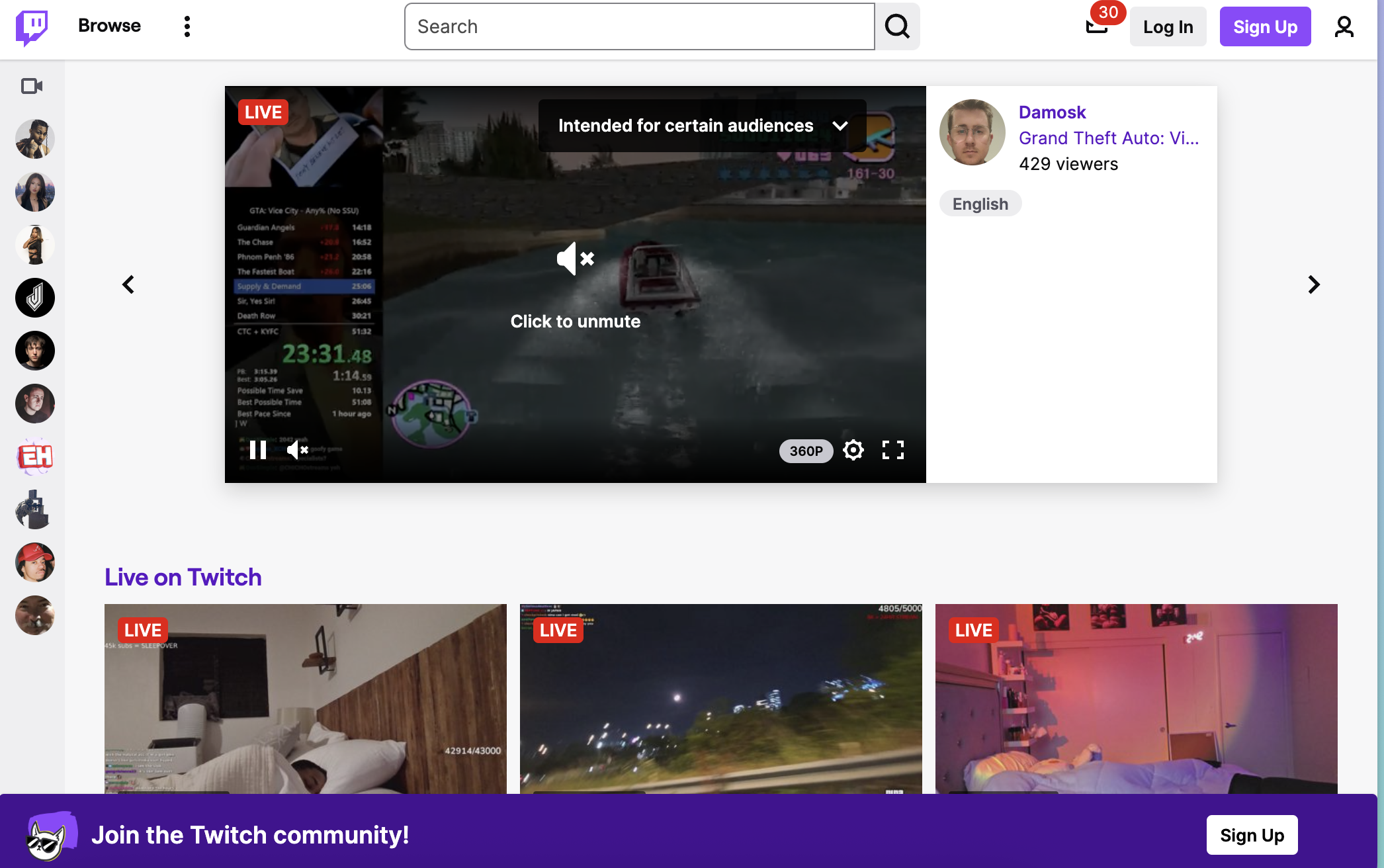
Twitch is the world’s leading live streaming platform, best known for gaming but increasingly home to creators in music, art, tech, fitness, and more. With 240 million monthly active users, Twitch enables direct, real-time audience interaction through live chat and subscriber communities.
Why Twitch works for brands and creators:
- Live content builds strong viewer relationships through real-time engagement
- Monetization options include subscriptions, donations, sponsorships, and ads
- A dedicated culture around creators, from emotes to channel raids to “Just Chatting” streams
If your brand or product fits naturally into entertainment, gaming, education, or behind-the-scenes content, Twitch can be a powerful space to grow your presence with video content that feels personal and participatory.
21. Discord
200 million monthly active users
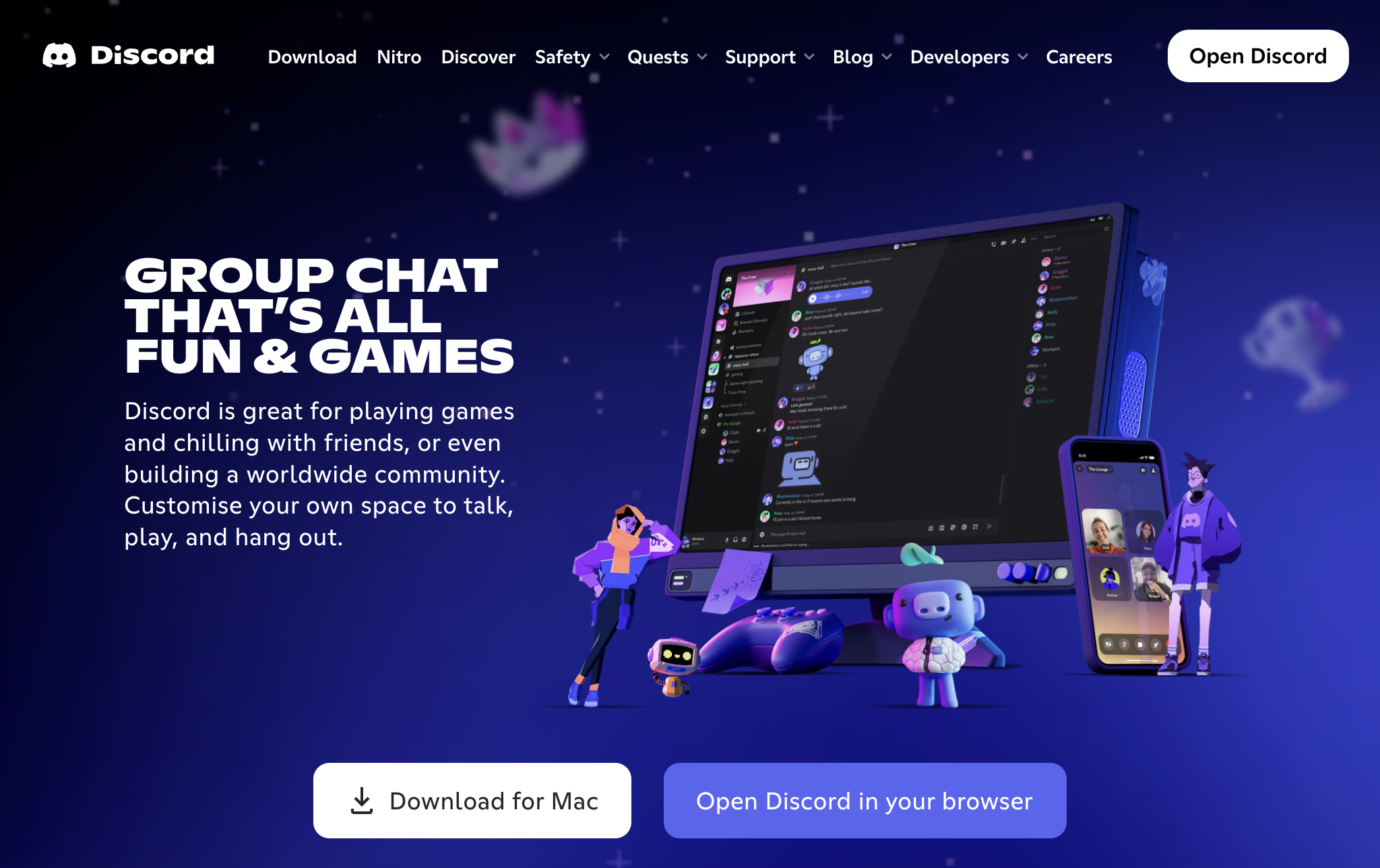
Discord started as a communication platform for gamers — but today, it powers communities across everything from entrepreneurship and crypto to education and creator spaces.
With 200 million monthly active users, Discord offers real-time messaging, voice chat, video calls, and deep customization for brands looking to build close-knit audiences.
Why Discord stands out:
- Fully customizable servers with private and public channels
- Great for building a sense of belonging through shared spaces, events, and exclusive content
- Can be used for product feedback, customer support, or behind-the-scenes access
While not a traditional social media platform, Discord is increasingly used by creators, businesses, and brands to deepen their social media presence through community-led conversations.
22. Tumblr
191 million monthly website visits
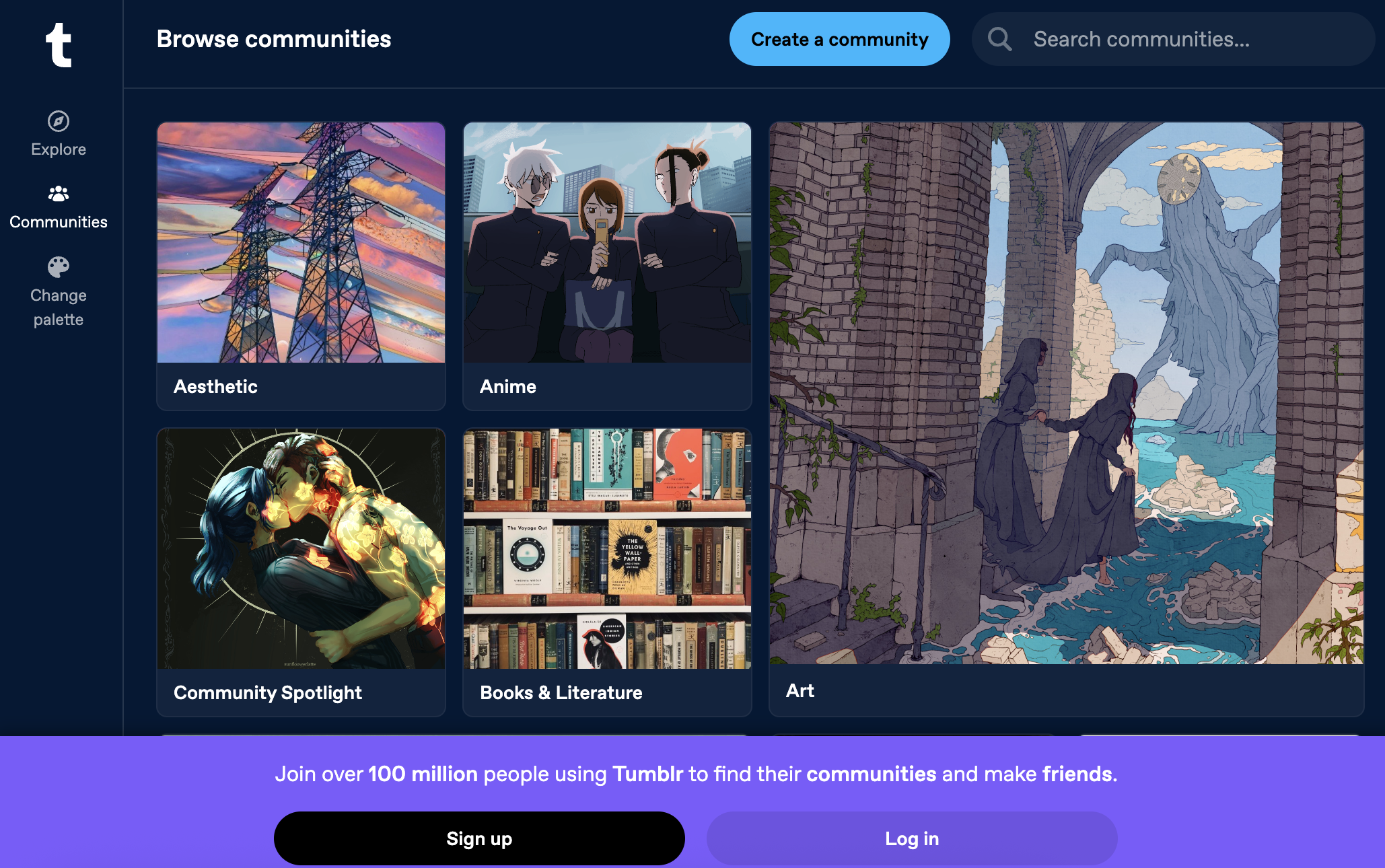
Tumblr is a long-running microblogging platform known for its creative freedom, highly engaged subcultures, and customizable blog layouts.
With 191 million monthly website visits, Tumblr has maintained a loyal community — particularly among artists, writers, fandoms, and younger users seeking a more expressive online space.
Why Tumblr still resonates:
- Supports nearly every media format: text, images, GIFs, video, audio, and links
- Allows deep blog customization — many users treat their Tumblr as a personal website or aesthetic diary
- Ideal for moodboarding, visual storytelling, and niche interests that don’t always fit mainstream platforms
Tumblr isn’t a must-use for every brand — but for those in creative industries or with strong visual and cultural identities, it can be a low-pressure way to build a unique social media presence.
23. Bluesky
30 million total users
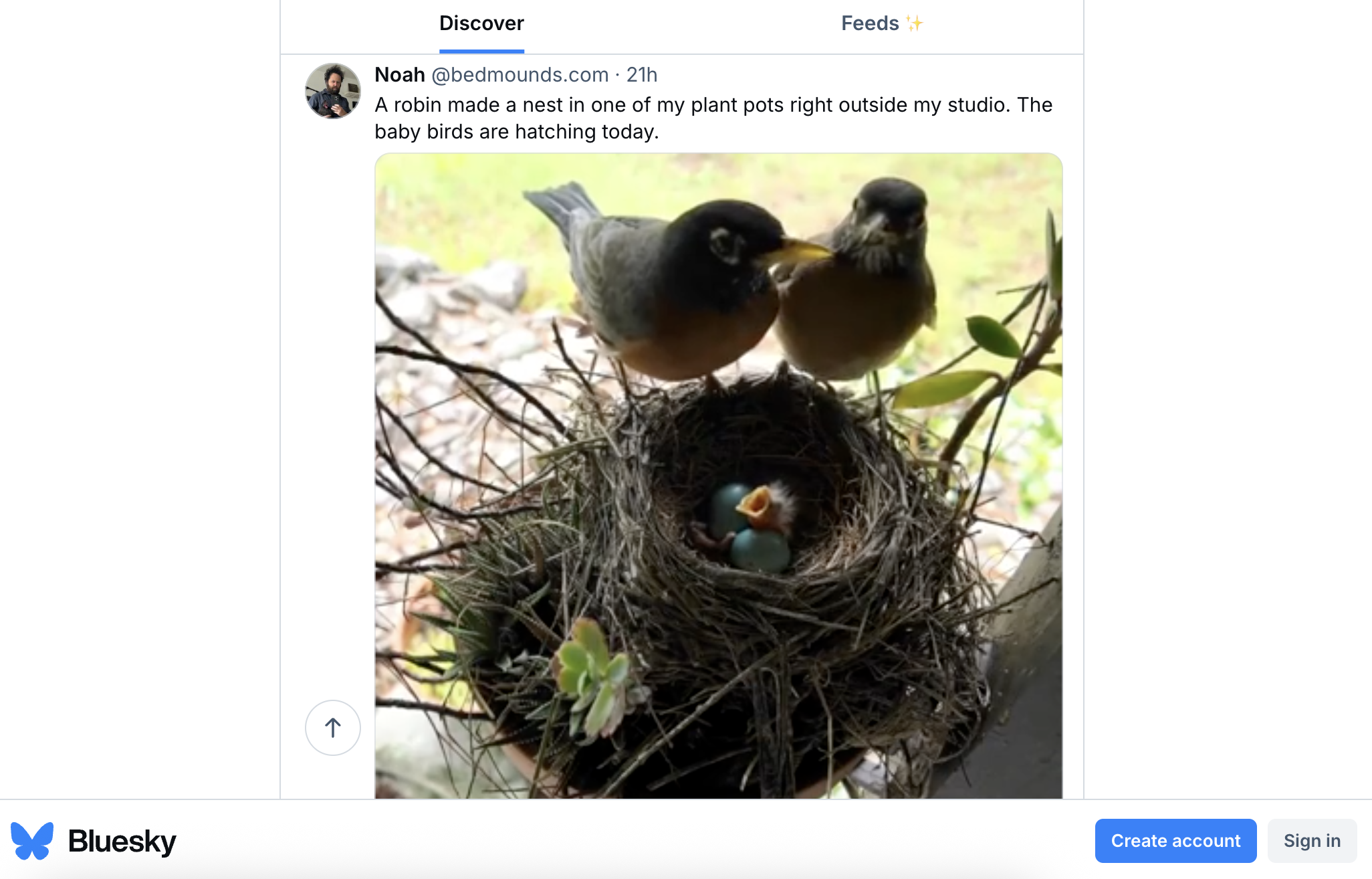
Bluesky is a decentralized social media platform originally incubated by Twitter and launched as an independent app in 2023.
With a focus on transparency and user control, Bluesky reached over 30 million total users by the end of 2024 — and continues to attract tech-savvy creators, developers, and community builders. Learn how to get started here.
What makes Bluesky unique:
- Built on the AT Protocol — an open-source network that allows users to control their data and algorithms
- Feels familiar to X/Twitter, with posts, replies, reposts, and likes
- Attracts a niche but growing user base interested in decentralization, creator ownership, and moderation transparency
Bluesky is still in early stages and not yet a mainstream platform, but it holds promise for creators and brands who want to engage in smaller, values-aligned communities or experiment with new distribution models.
24. Mastodon
8.1 million total users

Mastodon is a decentralized, open-source social media platform that gained traction in late 2022 as an alternative to mainstream networks.
With around 8.1 million total users, Mastodon is organized around independently hosted servers — or “instances” — that interconnect to form a broader network known as the Fediverse.
Why Mastodon appeals to niche audiences:
- No central authority — users join or create communities based on shared interests or values
- Prioritizes privacy, moderation transparency, and algorithm-free feeds
- Posts can be up to 5,000 characters and include images, video, or audio
Mastodon isn’t built for mass appeal — it’s designed for intentional communities and slower, more thoughtful real-time audience interaction. If your brand leans toward transparency, activism, or ethical tech, it could be a good fit for reputation-building.
Be selective with your social media presence
With so many social media platforms out there, it can be tempting to try them all — but the most effective social media marketing strategy isn’t about being everywhere. It’s about showing up intentionally, where your target audience already spends time, and where your content performs best.
Instead of managing five or six platforms halfway, pick two or three that align with your strengths, your goals, and your audience — then commit to showing up consistently and experimenting over time.
And if you’re managing multiple platforms, Buffer makes it easier to plan content, track performance, and stay organized — no matter how many accounts you run.
FAQs about social media platforms
What are social media platforms?
Social media platforms are online networks or apps where users create and share content, connect with others, and engage in communities. They range from messaging apps like WhatsApp to visual platforms like Instagram and video-sharing platforms like YouTube.
What are the top 5 social media platforms?
As of 2025, the top 5 social media platforms by monthly active users are:
- Facebook – 3.07 billion MAUs
- YouTube – 2.5 billion MAUs
- WhatsApp – 2 billion MAUs
- Instagram – 2 billion MAUs
- TikTok – 1.59 billion MAUs
These platforms offer the widest reach and broadest social media usage globally.
What are the top 5 popular apps in social media?
The most popular social media apps right now are:
- TikTok (short-form video)
- Instagram (visual storytelling)
- YouTube (long-form and short-form video)
- Facebook (broad content sharing and community)
- Threads (fast-growing text-first app from Meta)
Popularity can depend on audience age, region, and content format — so consider various social media platforms where your target audience is most active.
What is the hottest social media right now?
TikTok continues to dominate short-form video and cultural trends. But Threads and Xiaohongshu (RedNote) are quickly gaining traction in 2025, with younger audiences and creators exploring new ways to share, connect, and monetize.
Unless otherwise stated, these numbers are from Statista's report, 'Most popular social networks worldwide as of October 2024'.
Try Buffer for free
190,000+ creators, small businesses, and marketers use Buffer to grow their audiences every month.




